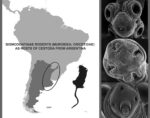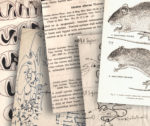Sigmodontinae rodents (Muroidea: Cricetidae) as hosts of Cestoda from Argentina
Natalia B. Guerreiro Martins, Victoria Canova, M. del Rosario Robles, Guillermo Panisse, Micaela Rojas, Carlos A. Galliari, Graciela T. NavoneIn Argentina, parasitological studies on Cricetidae rodents have been carried out mainly on nematodes. However, some research has shown that cestodes are also common components of their parasitic assemblages. In this study, Sigmodontinae rodents (Cricetidae–Muroidea) from the Cuenca del Plata, Argentina, are studied as hosts of cestodes. New host species, geographical areas, and parasitic infection parameters are provided. A total of 1675 specimens from 28 species of rodents from 67 localities were sampled for cestodes. Five taxa of cestodes belonging to three families were identified, including 20 new geographical records. In addition, nine new host-parasite associations are reported. These records help us to increase our understanding of the richness of cestodes in the region by providing a database to evaluate the effect of intrinsic and extrinsic factors on ecological indicators such as prevalence, abundance, and host specificity, among others.
Roedores Sigmodontinae (Muroidea: Cricetidae) como hospedadores de Cestoda de Argentina. En Argentina, los estudios parasitológicos en roedores Cricetidae han sido principalmente de nematodes. Sin embargo, algunas investigaciones han demostrado que los cestodes son componentes comunes de sus ensambles parasitarios. Los roedores Sigmodontinae (Cricetidae–Muroidea) de la región de la Cuenca del Plata, Argentina, son estudiados como hospedadores de cestodes. Se brindan nuevos registros hospedatorios y geográficos, y parámetros de infección parasitaria. Se examinaron 1675 especímenes pertenecientes a 28 especies de roedores de 67 localidades con el fin de hallar especímenes de cestodes. Se identificaron cinco taxones de cestodes pertenecientes a tres familias, entre los que se incluyen 20 nuevos registros geográficos. Además, se informan nueve nuevas asociaciones parásito-hospedador. Estos registros nos ayudan a aumentar nuestra comprensión de la riqueza de los cestodes en la región, y proporcionan una base de datos para evaluar el efecto de los factores intrínsecos y extrínsecos sobre los indicadores ecológicos, como prevalencia, abundancia, especificidad hospedatoria, entre otros.

